
Monetary Policy
The Bank kept its policy interest rate at 1.75 percent in 2019, below its estimated range for the neutral policy rate. As such, monetary policy remained accommodative as the Canadian economy continued to adjust to economic challenges globally and in the oil sector.
In focus: Digitalization and the Bank

Financial System
Canada’s financial system remained highly resilient in 2019. Its ability to withstand shocks has been enhanced by policies that have strengthened the banking system and improved the operational resilience of important financial institutions and major payment systems.
In focus: Modernizing Canada’s payment systems

Funds Management
To enhance the resilience of its market and banking operations, the Bank opened a new location in Calgary in 2019. Since then, the Calgary Operational Site has been conducting banking and market operations in conjunction with head office.
In focus: Enhancing operational resilience

Currency
The Bank continued to provide Canadians secure, polymer notes with cutting-edge security features that make them easy to check and difficult to counterfeit. This is reflected in Canada’s low counterfeiting rate.
In focus: Researching a central bank digital currency

Communications and Outreach
The Bank continued to enrich and expand its stakeholder engagement activities. This included a variety of engagements related to the 2021 renewal of the inflation-control target agreement with the Government of Canada.
In focus: Communicating with Canadians

Managing the Bank
The Bank’s core functions and activities are built on strong operations and management. Efficient, cost-effective and innovative operations continue to help the Bank to achieve its business objectives. This year, the Bank’s head office in Ottawa was awarded Gold Certification in Leadership in Energy and Environmental Design (LEED).
In focus: The economics of climate change
Governor's Foreword
2019: Emphasis on stewardship
December, 2019
The Bank of Canada has always prided itself on its stewardship—of the Canadian economy, of course, but also of the organization, its people and its resources. As I approach the end of my seven-year mandate as Governor, I find myself thinking more and more about the situation that I will hand over to the next Governor.
Let me begin with stewardship of the organization. The Bank manages its resources through its medium-term plan (MTP), which is developed every three years in collaboration with the Board of Directors. Our 12 outside directors bring a wide diversity of experience to our boardroom, from the private and public sectors and from all regions of the country. Development of the MTP includes thinking about alternative futures and ensuring that the Bank is prepared to deal with them. For example, several years ago we decided that the Bank needed to prepare itself for the possibility that bank notes would someday become obsolete. That led us to invest early in experiments using distributed ledger technology (blockchain) and to think through the issues around central bank digital currencies. Today, we believe that cash will remain a popular payment vehicle, but we are already close to having a full contingency plan should it not.
2019 at a Glance
$111.8B
Gross value of marketable bonds issued in 2019
$73.6B
Market value of liquid reserves held in the Exchange Fund Account in US dollars as at December 31, 2019
$1.3B
Net income for the Bank in 2019
47
Bank research papers published in peer-reviewed academic journals
2.5B
Number of bank notes in circulation
$93.1B
Total value of bank notes in circulation
The Bank’s MTP is particularly rigorous around resources. We separate our resource plan into three buckets: core operations, investments and new mandates. The operational envelope has been stable for many years, consisting of 1,500 people (plus or minus 1 percent) and a 2 percent cap on annual expenditure growth. Investments are in addition to that and include spending on such things as renewing our headquarters, replacing technology and cyber resilience. For example, replacing our Canada bond auction system requires new purchases, plus some temporary hands to do the build. When the job is done, the system builders and consultants will leave; but some people will need to maintain the system, and they must then become part of the core operational envelope and fit within the cap. New mandates, in contrast, are about new tasks the Bank takes on, such as retail payments system oversight, which is expected to happen in 2020; this will eventually require a permanent increase in our core resource envelope.
This planning framework prevents the sort of incremental thinking and spending that can enter any organization. Investments create temporary bulges in total spending but are overseen directly by management and by the Board of Directors. These extra layers of oversight help to prevent mission creep and cost overruns, especially in technology investments. Initiatives that do not represent an investment or a new mandate must be financed out of the core envelope through efficiency gains or reallocations, which can mean abandoning less important activities. For example, in developing the MTP for 2019–21, our leadership group identified the need to allocate resources dedicated to (1) developing a next-generation macroeconomic forecasting model, (2) creating a concrete contingency plan should issuance of digital currency prove necessary sometime in the future, and (3) advancing our analysis of the implications of climate change. Given these new priorities, our leaders reallocated more than 30 positions within our 1,500-person cap this past year. This was done collaboratively by our cadre of managers. All this fine stewardship is supported by top-notch succession planning and leadership development and a performance and compensation system with a heavy emphasis on leadership behaviours. Personally, I devoted more than 80 hours to one-on-one mentoring of senior leaders in 2019, as agreed with the Board of Directors.
The organization accomplished many important things in 2019. The Bank opened and staffed a new operational site in Calgary, which is designed to take over all essential operations in case of a major disruption in Ottawa. Already, critical operations are being routinely managed jointly or being rotated between the two locations. We launched and began to implement a new cyber security strategy, integrating the Bank’s critical role within the Canadian financial system. We also provided material support to Payments Canada’s initiative to modernize Canada’s core payment systems: the new wholesale system will go live in 2021, and the retail system about two years later. In addition, the Bank pressed on with its own digital transformation, experimenting with several emerging technologies and exploring ways to deploy artificial intelligence and advanced analytics into its routine processes. Nowhere is this more evident than in the Bank’s communications. We have broadened the Bank’s reach and external impact; we published the first fully digital Financial System Review in 2019 and began layering our articles and speeches to make them more accessible and relevant to different types of readers. The Economy, Plain and Simple is our first series to use multiple media, and the Bank of Canada Museum set a new attendance record in 2019.
2019 at a Glance
72,310
Number of visitors to the Bank of Canada Museum
50%
New Visiting Scholars who are women
$281,456
Total staff donations to the Bank of Canada workplace charitable campaign
10
Consecutive years the Bank has been named one of Canada’s Top 100 Employers
5,000
Number of trees the Bank will plant to commemorate its 10th consecutive Top 100 Employers Award
1,800
Approximate number of Bank employees (1,500 core + 300 projects)
Let us turn now to stewardship of the Canadian economy. Amid the hype and breathless commentary around each variation in the data, one can lose sight of just how resilient the economy has been. That resilience has been sorely tested over the past three years, mostly through rhetoric and actions related to international trade. This has fostered deep uncertainty about the future of many businesses, in Canada and elsewhere, causing significant pullbacks in business investment and international trade. On top of this, there was yet another downdraft in global and especially Canadian oil prices to start 2019, deepening the already-severe adjustments to lower prices that had been underway since 2015. Finally, 2018 had seen several new prudential measures put in place to manage risks related to mortgages, along with several interest rate hikes. Last year at this time, the Bank was carefully watching to see how these developments would affect the Canadian economy, particularly the housing market.
The global economy slowed significantly in 2019, but by year-end there were signs that things were levelling off. Indeed, the Bank expects global economic growth to edge slightly higher in 2020. This does not mean that trade turmoil and related uncertainty are no longer having negative effects: the level of global gross domestic product (GDP) is now permanently lower than it otherwise would have been in the absence of new trade policies. By the end of 2020, we expect the cumulative cost to the world to approach US$1 trillion, or over 1 percent of GDP. However, as companies adapt to the new situation, economic growth should pick up, albeit more moderately and from a lower level of output.
Despite all this, the Canadian economy grew just a touch less during 2019 than we expected a year ago. This is because housing and related household spending stabilized and contributed to growth, even as soft investment and exports continued to hold back the economy’s expansion. In other words, Canada is not immune to global trade conflict, but for most of 2019 the negatives were offset by some positives. While many central banks cut interest rates during 2019, rates in Canada held steady amid these contrary forces. This prompted considerable commentary about policy divergence between Canada and the United States—even though US rates have now declined to Canadian levels, having previously diverged on the upside. Even so, Canadian mortgage rates were drawn down in 2019 by developments in the global bond market. This helped to support household spending and the housing market. It also served as a reminder that Canadian households are already carrying record levels of debt, which makes them vulnerable to future shocks. However, the new mortgage lending rules are having their intended effect, making the household sector more resilient to future developments.
Inflation is on target and has been there for most of the past two years—a significant achievement in light of the turbulence the economy has been through.
All this to say that the Canadian economy is in a good place overall, even if it is not in a good place everywhere. For one thing, we would prefer a more sustainable situation with more growth in exports and investment and more moderation in housing and household indebtedness. We would also prefer that the economy be better balanced regionally. Given continuing adjustments to low oil prices and ongoing transportation constraints, oil-producing regions of Canada continue to struggle relative to the rest of the country. Over history, it has been rare for all regions and all sectors of the Canadian economy to be expanding at the same time. Today’s conditions are in many ways the reverse of what we saw from 2008 to 2014, when oil prices and the Canadian dollar were high and conditions outside the oil-producing regions were challenging. In other words, even if the economy is roughly where it belongs, it is not true for every region or for every individual. There is work yet to be done—adjustments are ongoing, and confidence remains soft.
The good news is that inflation is on target and has been there for most of the past two years—a significant achievement in light of the turbulence the economy has been through. Maintaining low and stable inflation is the central tenet of our policy framework, delivering financial stability to all Canadians and a well-functioning real economy and labour market. Today, unemployment is near its all-time low. In the past seven years, unemployment rates have fallen significantly across all age groups, even as labour force participation has risen. Overall, the economy is operating close to full capacity, with evidence of slack only in certain regions and specific sectors. In other words, the macroeconomy has made it home, after more than 10 years of difficult adjustments.
2019 at a Glance
1.75%
Policy interest rate at year-end
76.99 US cents
Exchange rate for 1 Canadian dollar as at December 31, 2019
$1.0B
Amount remitted by the Bank to the Receiver General for Canada
2%
Inflation-control target
1.9%
CPI inflation
1.6%
Canada’s real GDP growth as estimated at December 31, 2019
Watch Governor Poloz speak about the Bank’s 2020 Vision.
Looking back on my term as Governor, I could not be more proud of the researchers and forecasters at the Bank, who have consistently done a superb job of guiding our policy deliberations. They have done timely analysis of trade actions; of new housing policies; of complex developments in the labour market, including rapid immigration; of large fluctuations in oil prices; and of the effects of uncertainty on business investment. The Bank’s forecast performance can easily get lost in the daily ebb and flow of economic data and private sector forecast updates because Bank staff deliver their forecasts only four times per year and let them stand for the subsequent three months. This is because monetary policy must act in a longer-term context that fosters stability, with a view to achieving the inflation target, rather than being blown around by shifting winds. A key complicating ingredient of policy making today is the presence of risks associated with elevated household indebtedness. Bank researchers have leveraged new datasets to help us understand consumer financial stresses as well as vulnerabilities in corporate debt funding. They have also developed new tools to allow us to take these risks into account in a formal way, which is a major advance in policy formulation and communication.
Looking back on my term as Governor, I could not be more proud of the researchers and forecasters at the Bank, who have consistently done a superb job of guiding our policy deliberations.
Fundamentally, monetary policy depends on forming judgments across a wide array of such considerations, each of which is wrapped in uncertainty. Indeed, if one phrase can sum up the past few years, it is unprecedented uncertainty, for it has been far greater than normal and has touched every dimension of the economy. And these judgments simply could not have been made without exceptionally good advice from cutting-edge researchers and seasoned policy-makers.
To sum up, I am increasingly confident that the next Governor will begin work with a vibrant, healthy and balanced organization, one that was just named a Top 100 Employer in Canada for the 10th consecutive year. The new Governor will also begin with the Canadian economy in a much-improved condition, albeit still vulnerable to new adverse developments, whether international or domestic. The progress that has been made on both fronts can only be attributed to outstanding teamwork, from both my own executive team and our Board of Directors. My thanks to them all for their dedication to the Bank’s vision: to be a leading central bank—dynamic, engaged and trusted—committed to a better Canada.
Stephen S. Poloz
Governor
